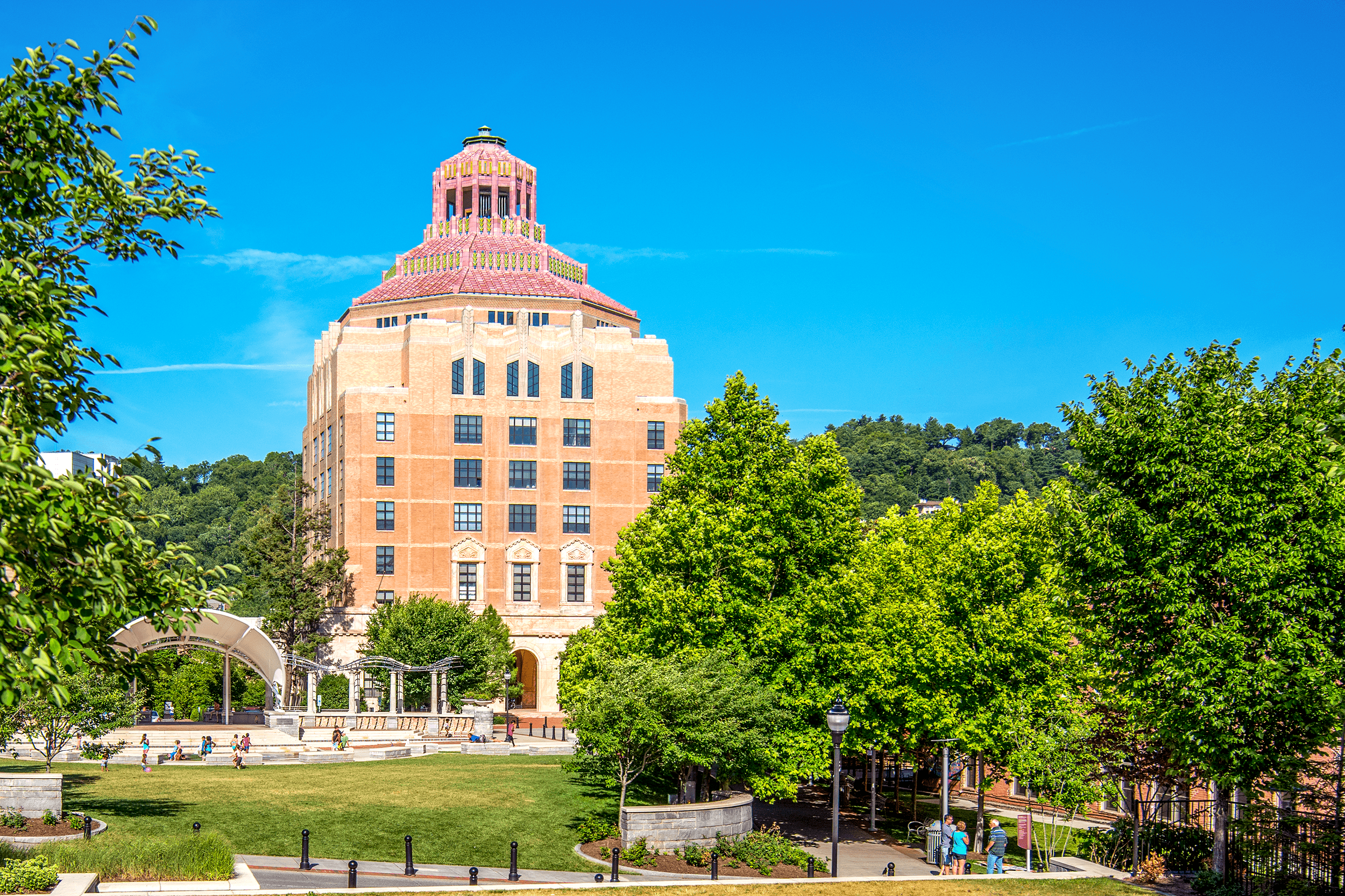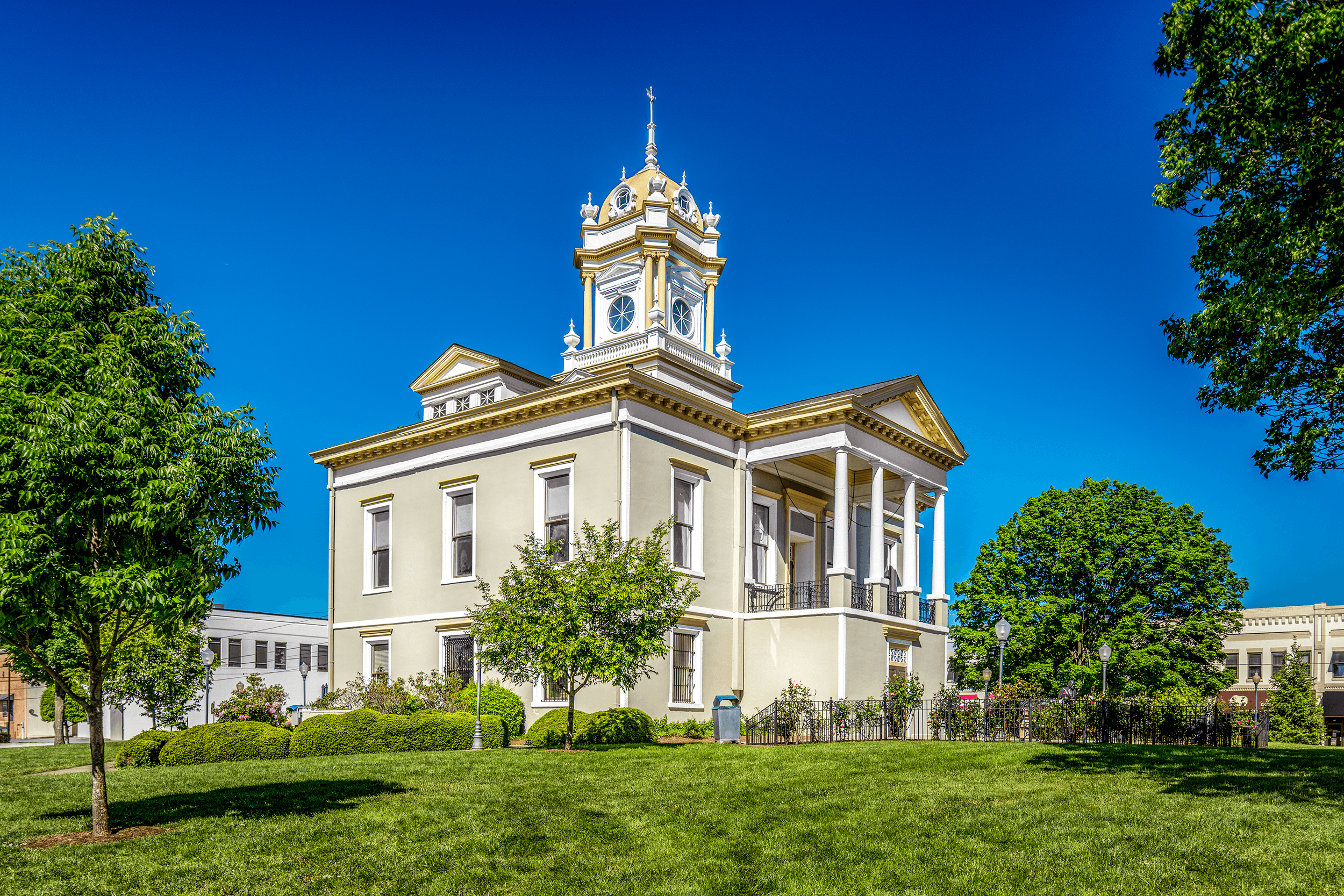Brinegar Cabin at Doughton Park

Updated: April 2019
Life in the Mountains at Doughton Park
In 1876 Martin Brinegar purchased this 125-acre farm from Henderson Crouse, Caroline Joines’ uncle, for $200. Two years later, at age 21, Martin Brinegar married Caroline, who was 16. They lived on this farm for nearly 60 years. The property consists of a cabin, a shed, and a springhouse, which is where perishable goods were stored. Descendants of their three children Renee, Alice and John often come to this site to visit their home place.
The Brinegar Cabin is located in Doughton Park near Milepost 239.
Life at the Brinegar Cabin More Than 100 Years Ago
In 1988 Barry M. Buxton wrote an excellent study about the Brinegar Cabin, where he vividly described farm life in the Highlands more than 100 years ago:
“With no electricity, no running water or plumbing, and no central heating system, it was indeed a very different existence from ours today. It was a day full of hardship and pain. Martin and Caroline would arise about four in the morning to begin their daily chores. The Brinegars were mostly self-sufficient. They grew the vegetables they consumed and maintained livestock for slaughter. Martin also maintained a small orchard of apple trees - around 25 to 30 trees. The family also grew cabbage and potatoes to sell in the fall. With the cash, they purchased flour, sugar and other staples not grown on the farm. The entire family participated in gathering wild berries. They were eaten fresh or used for preserves, which Caroline made. She worked every bit as hard as Martin. Caroline picked and dried the wild fruit, washed the wool, carded, spun, and wove it, made soap, hominy, butter, lard, and molasses. She helped cut up the meat and raised the poultry. Oh yes, and if that wasn’t enough, she had her share of milking cows and hauling wood and water.
Perhaps most notable was Caroline’s spinning and weaving, which were the primary home industry throughout the Highlands. As with other mountain women, she did her spinning on a wheel. Unfortunately, spinning was a painfully slow process. It takes as many as eight spinners to supply yarn for one weaver. Spinning was an activity in which Caroline involved all her children during their spare time. Not just Renee and Alice, but also John. This help was necessary to keep the weaving process going. Caroline used roots, bark, and leaves to dye the cloth.
Martin was also a cobbler and made shoes for family and neighbors. Leather, thread, and homemade wooden pegs were the primary materials used in the process. He spent countless hours measuring and cutting the leather and sewing it into boot-like ankle shoes. It took Martin about two weeks to make one pair of shoes, which would last only two years if you wore them carefully. A pair would cost $1.
Martin Brinegar was a devoutly religious man. He attended the Pleasant Grove Union Baptist Church, where he held the honored position of Clerk. He regularly attended monthly services, which lasted for two days. Services only met once a month in most rural communities because the preacher was on a circuit and ministered to the needs of three or four congregations in different communities. Another reason for the monthly meetings was the distance members of the congregation had to travel to get to church. Martin walked from the cabin to church (about nine miles) or occasionally rode horseback”.
As one of the largest parks in North Carolina, the 7,000-acre Doughton Park is an excellent destination for hikers, offering seven different trails ranging from 1 mile to 7.5 miles one way. It also has a large campground on the north-eastern side of the park near Milepost 239. There is also a primitive campsite inside the park, which may be a good option for more adventurous hikers, who love backcountry camping.
Doughton Park is One of the Largest Parks in North Carolina
Doughton Park offers more than 30 miles of hiking trails spread over seven trails of varying degrees of difficulty and lengths. The trails of this 7,000-acre (28.3 km²) park, which is one of the largest parks in North Carolina, lead through rolling ridgetop meadows and past cascading waterfalls.
Fodder Stack Trail (easy to moderate – 2-mile loop):
Close to the parking lot near Milepost 241 on the Blue Ridge Parkway, this easy to moderate loop represents a cross-section of the park’s wildflowers and forests. The trail has a short steep section at the start.
Bluff Mountain Trail (easy – 7.5 miles):
The Bluff Mountain Trail travels along the Blue Ridge Parkway and can be accessed from several locations. The trail leads through relatively flat terrain and reaches Brinegar Cabin at Milepost 238.
Cedar Ridge Trail (strenuous – 4.4 miles):
This beautiful but strenuous trail descends a forested ridgeline from the Brinegar Cabin to the southern end of Grassy Gap Fire Road. The elevation change is more than 2,000 feet.
Grassy Gap Fire Road (moderate - 6.5 miles):
This leaf-covered lane is wide enough to accommodate horseback riders and hikers. The trail starts at Milepost 243.9 and ends at State Route 1730 (Longbottom Road). Horseback riders must enter and exit the trail from Longbottom Road.
Basin Creek Trail (moderate – 3.3 miles):
The Basin Creek Trail can only be accessed from the Grassy Gap Fire Road. The trail passes cascading waterfalls and reaches at the end the century-old Caudill Cabin, which was the home of the Caudill Family in the early 1900s. Part of the once-thriving Basin Cove community, this cabin was one of the few structures that survived the devastating flood of 1916.
Bluff Ridge Primitive Trail (strenuous – 2.8 miles):
This trail is the shortest but steepest route into Basin Cove. You may want to allow extra time for this strenuous hike.
Flat Rock Ridge Trail (moderate – 5 miles):
The Flat Rock Ridge Trail starts close to the Basin Cover Overlook at Milepost 244.7 on the Blue Ridge Parkway and ends at State Route 1730 (Longbottom Road). This trail leads from the mountaintop meadow at Basin Cover Overlook to the damp, cool banks of Basin Cove Creek along the Grassy Gap Fire Road. Hikers can appreciate the rugged terrain early settlers had to handle.
Camping
A large campground with tables, campfire rings and grills is located near Milepost 239 on the Blue Ridge Parkway. Reservations can be made under telephone → (336) 372 8877.
For more adventurous, backcountry campers a primitive campsite is located at the junction of Bluff Ridge Primitive Trail and Grassy Gap Fire Road. Permits can be obtained at the Ranger Office at 49800 Blue Ridge Parkway, Laurel Springs, NC 28644. Telephone: → (336) 372 8568.
View Bluff Mountain at Milepost 243.4 on the Blue Ridge Parkway offers beautiful vistas overlooking Doughton Park. It also provides hikers access to the easy 7.5-mile (12 km) Bluff Mountain Trail, which reaches the Brinegar Cabin after 4.7 miles (7.6 km).
View Bluff Mountain
View Bluff Mountain at Milepost 243.4 on the Blue Ridge Parkway offers beautiful vistas overlooking Doughton Park.
From the midsection of the parking area at an elevation of 3,334 feet (1,016 meters), hikers have access to the easy 7.5-mile (12 km) Bluff Mountain Trail, which leads to the Brinegar Cabin.
A short path brings hikers to the trail. Heading left, hikers reach the Brinegar Cabin after 4.7 miles (7.6 km). The trail to the right is a short 1.6-mile (2.6 km) hike to the Basin Cove Overlook.
The Basin Cove Overlook at Milepost 244.7 on the Blue Ridge Parkway is a picturesque spot with long-range views and a big old photogenic pine tree. The southeast facing overlook is situated at an elevation of 3,312 feet (1,009 meters). Two hiking trails, the Bluff Mountain Trail and the Flat Rock Ridge Trail, start from the overlook.
Basin Cove Overlook
The Basin Cove Overlook at Milepost 244.7 on the Blue Ridge Parkway is a picturesque spot with long-range views and a photogenic pine tree, giving just enough shade for a lovely picnic with expansive vistas as a backdrop.
The southeast facing overlook is situated at an elevation of 3,312 feet (1,009 meters).
Along the Blue Ridge Parkway, the Basin Cove Overlook marks the southern point of Doughton Park and accesses the easy 7.5-mile (12 km) Bluff Mountain Trail, which leads to the Brinegar Cabin.
From the overlook, hikers can also access the moderate 5-mile (8 km) Flat Rock Ridge Trail, which ends at the damp, cool banks of Basin Cove Creek by State Route 1730 (Longbottom Road).
A large map is located at the trailhead.
Milepost 241 Blue Ridge Parkway, Laurel Springs, NC 28644
Tel.: → (336) 372-8568
Dawn to dusk.
All year.
Large Campground:
May to October.
Park:
Free admission.
Along the Blue Ridge Parkway between Mileposts 238 and 245.
Doughton Park offers in total 7 trails ranging from easy to strenuous and of different lengths. Please use your own discretion.
Picnic tables are located in the park near Milepost 241 off the Blue Ridge Parkway.
Restrooms are located at Bluff’s Picnic Area and between Mileposts 241 and 242 and at the camp ground between Mileposts 239 and 240.








